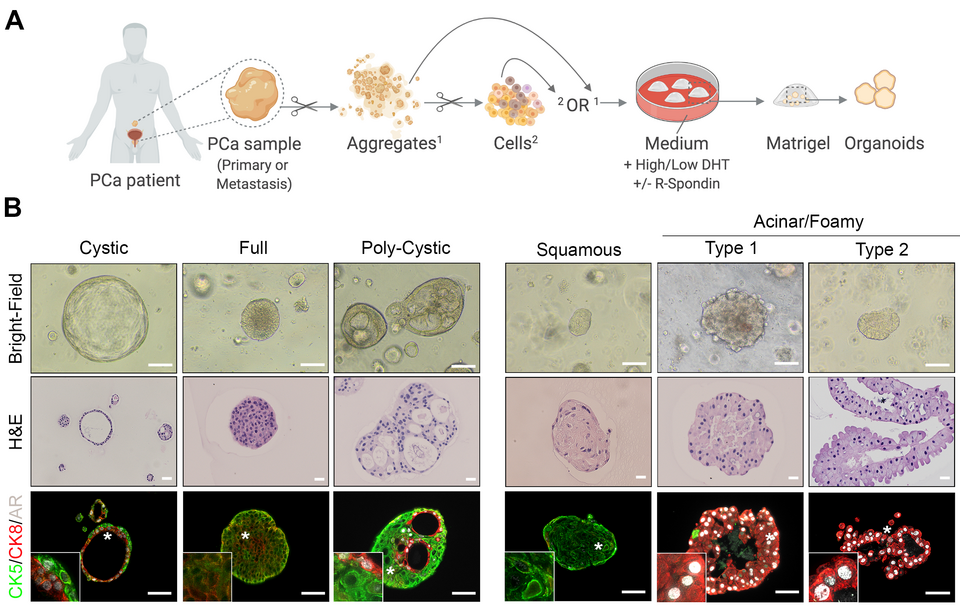Prostate Cancer . Bladder Cancer . Patient-derived organoids . Treatment resistance . Cellular heterogeneity . Plasticity
Translational Genitourinary Cancer Research
Mechanisms of prostate cancer and bladder cancer progression
Relying on a strong connection with the clinic, the laboratory for Translational Genitourinary Cancer Research (TGCR) combines both basic and translational research, with the long-term goal of impacting the management and treatment of urological cancers. Our research particularly focuses on investigating mechanisms driving prostate cancer (PCa) and bladder cancer (BC) progression by pursuing two main research lines:
Developing patient-derived models for basic and translational research
We primarily aim at developing ex vivo models that (i) derive from patients’ clinical material, (ii) closely recapitulate molecular and cellular features of the sample they derive from, and (iii) are easily amenable to genetic modification for functional analyses and/or to drug treatment for personalized medicine approaches. Among these models, patient-derived organoids (PDOs) represent promising tools, yet their establishment has proven to be challenging in the context of PCa. In our laboratory, we have adopted an approach to test different experimental strategies (Figure 1) and identify factors that may dictate the success or failure of organoid generation (Servant et al. 2021). This led to the generation of novel organoid models that recapitulate specific PCa molecular subtypes and respond to clinically relevant drugs (Figure 2). This work also highlighted the need to improve the systems for better efficiency, a challenge that we are addressing in the context of both PCa and BC, in an ongoing project funded by the Swiss Cancer League. Finally, we have demonstrated that PCa and BC PDOs are tumorigenic in vivo, thereby providing further opportunities for mechanistic and translational studies. In parallel to PDOs, we are developing complementary 3D models that integrate components of the tissue microenvironment in the context of an interdisciplinary grant funded by the Department of Surgery of the University Hospital Basel.
Investigating cell heterogeneity, cellular plasticity and treatment response
Cellular plasticity may be largely accountable for intratumoral heterogeneity, a phenomenon which is frequently observed in PCa and impacts tumor progression and treatment resistance (Le Magnen et al. 2018). Complementary to our modeling efforts, our research therefore aims at dissecting cellular heterogeneity in the context of resistance to androgen-deprivation therapy (i.e. “castration-resistance”), the mainstay for treatment of advanced PCa. In this framework, our preliminary findings highlighted stemness-associated patterns that are associated with the development of castration-resistant PCa (Federer-Gsponer et al. 2020). Building on this study and on our organoid work, we are now exploiting single-cell based approaches (scRNA-seq, CODEX), organoid models and longitudinal cohorts of clinical samples to investigate cellular dynamics underlying response to androgen-targeted therapies at single-cell level (project funded by the SNSF and KLbB). We envision that this study will lead to the identification of refined prognostic and predictive markers, as well as novel therapeutic targets for advanced PCa. Using similar technologies, we are using patients’ samples and PDO models recapitulating specific molecular subtypes to decipher basic mechanisms driving cellular plasticity in the context of BC (Figure 3).
Connection to Clinical Practice
Our laboratory is a joint venture between the Institute of Pathology and the Department of Urology at the University Hospital Basel. As such, it relies on a strong connection with the clinic and on a close collaboration with urologists (Prof. Helge Seifert, Prof. Cyrill Rentsch) and pathologists (Prof. Lukas Bubendorf, PD Dr. Tatjana Vlajnic), who are directly involved in the research projects. Access to relevant clinical samples is further enhanced through our collaboration with the Departments of Urology and Oncology at St. Clara Hospital and the department of Urology of Kantonsspital Baselland. With this interdisciplinary setting, we ensure the clinical relevance of our findings and expect accelerating efforts towards personalized medicine approaches for patients with advanced urological cancers.

Figure 1. Prostate cancer patient-derived organoids. (A) Cartoon depicting the experimental strategy to establish organoids derived from primary PCa or PCa metastasis (B) Bright field images, corresponding H&E staining, and immunofluorescence analysis for the indicated antibodies in selected organoids representative of five major morpho-histological subtypes.

Figure 2. A new organoid model of hormone-naïve PCa which displays sensitivity to androgen-targeted therapies (A) Organoids derived from a hormone-naïve lung metastasis sample (P20-11-Lg) were established after 10 days of culture. (B-C) P20-11-Lg organoids recapitulate phenotypic and genomic features of the patient’s sample they are derived from. (D) Culture of P20-11-Lg organoids with high (1nM), low (0.1 nM) or no DHT (0 nM) leads to significant decreased survival (E) Treatment of P20-11-Lg organoids with different concentrations of Enzalutamide or Abiraterone.

